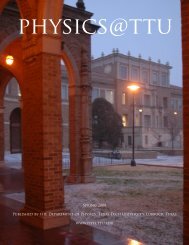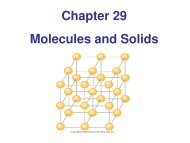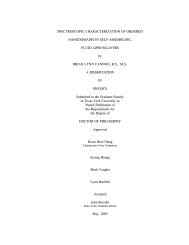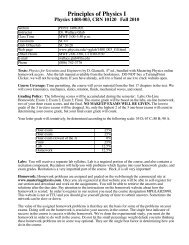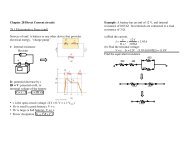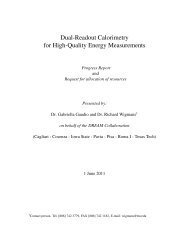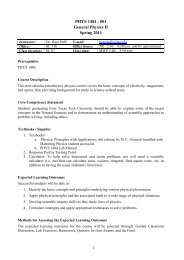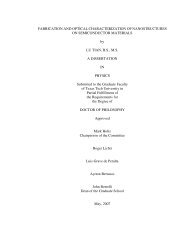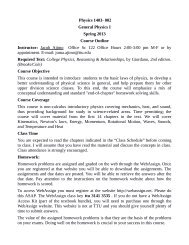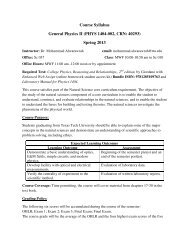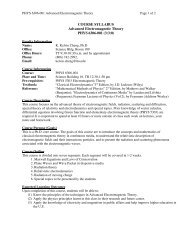Version One â Homework 1 â Juyang Huang â 24018 â Jan 16 ...
Version One â Homework 1 â Juyang Huang â 24018 â Jan 16 ...
Version One â Homework 1 â Juyang Huang â 24018 â Jan 16 ...
Create successful ePaper yourself
Turn your PDF publications into a flip-book with our unique Google optimized e-Paper software.
<strong>Version</strong> <strong>One</strong> – <strong>Homework</strong> 1 – <strong>Juyang</strong> <strong>Huang</strong> – <strong>24018</strong> – <strong>Jan</strong> <strong>16</strong>, 2008 18<br />
supplied by the ignition circuit<br />
Correct answer: 1800 V.<br />
Explanation:<br />
Let : E = 3 × 10 6 V/m and<br />
d = 0.06 cm = 0.0006 m .<br />
Assuming the electric field between the two<br />
electrodes is constant, then the potential difference<br />
between the electrodes is<br />
keywords:<br />
V = E d<br />
= ( 3 × 10 6 V/m ) (0.0006 m)<br />
= 1800 V .<br />
Accelerating an Electron<br />
25:05, trigonometry, numeric, > 1 min, normal.<br />
040 (part 1 of 1) 10 points<br />
Through what potential difference would an<br />
electron need to be accelerated for it to<br />
achieve a speed of 4 % of the speed of light<br />
(2.99792 × 10 8 m/s), starting from rest<br />
Correct answer: 408.799 V.<br />
Explanation:<br />
Let : s = 4% = 0.04 ,<br />
c = 2.99792 × 10 8 m/s ,<br />
m e = 9.10939 × 10 −31 kg ,<br />
q e = 1.60218 × 10 −19 C .<br />
The speed of the electron is<br />
v = 0.04 c<br />
= 0.04 ( 2.99792 × 10 8 m/s )<br />
= 1.19917 × 10 7 m/s ,<br />
By conservation of energy<br />
1<br />
2 m e v 2 = −(−q e ) ∆V<br />
and<br />
v 2<br />
∆V = m e<br />
2 q e<br />
= ( 9.10939 × 10 −31 kg )<br />
(<br />
1.19917 × 10 7 m/s ) 2<br />
×<br />
2 (1.60218 × 10 −19 C)<br />
= 408.799 V .<br />
keywords:<br />
Point Charge<br />
25:05, trigonometry, numeric, > 1 min, normal.<br />
041 (part 1 of 1) 10 points<br />
At distance r from a point charge q, the electric<br />
potential is 600 V and the magnitude of<br />
the electric field is 200 N/C.<br />
Determine the value of q.<br />
Correct answer: 2.00277 × 10 −7 C.<br />
Explanation:<br />
Let : k e = 8.98755 × 10 9 N · m 2 /C 2 ,<br />
V = 600 V , and<br />
e = 200 N/C .<br />
E = k e q<br />
r 2 and V = k e q<br />
r , so that V E = r.<br />
The potential is<br />
V = k e q<br />
r<br />
= k e q<br />
V<br />
E<br />
= k e q E<br />
V<br />
q = V 2<br />
k e E<br />
(600 V) 2<br />
=<br />
(8.98755 × 10 9 N · m 2 /C 2 ) (200 N/C)<br />
= 2.00277 × 10 −7 C .<br />
keywords:<br />
Conducting Spheres 02<br />
25:09, trigonometry, multiple choice, > 1 min,<br />
wording-variable.<br />
042 (part 1 of 4) 10 points<br />
Consider two “solid” conducting spheres with<br />
radii r 1 = 4 R and r 2 = 3 R ; i.e.,<br />
r 2<br />
r 1<br />
= 3 R<br />
4 R = 3 4 .



